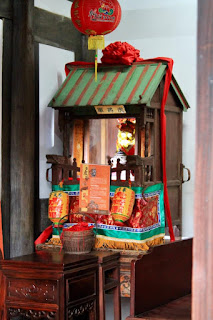Ich habe für heute einen Ausflug gebucht, wir besuchen ein historisches Wohnhaus und einen konfuzianischen Tempel in der Hauptstadt Taipei, eine Fahrt von rund zwei Stunden vom Hafen Keelung entfernt.
Die Fahrt ist kurzweilig und unterhaltsam, unser Reiseleiter erzählt uns viele interessante Dinge und mir tun die Gäste etwas leid, die einen Ausflug auf den Turm Taipei101 gebucht haben, er ist das zehnthöchste Gebäude der Welt zur Zeit und an sonnigen Tagen hat man einen grandiosen Überblick über vermutlich die gesamte Insel, aber heute regnet es halt.
Wir aber fahren zum Haus der Familie Lin. Also, wir fahren dahin, wo das Haus jetzt steht. Im Zuge von Bauarbeiten und Straßenerweiterungen sollte das völlig marode Gebäude abgerissen werden, allerdings haben zu viele Leute protestiert, darum wurde es umgesetzt und restauriert.
Im 18. Jahrhundert kam Lin Ching-Ming aus der Fujian Provinz aus China nach Taiwan, er war Händler und die Geschäfte gingen gut und sein vierter Sohn errichtete 1783-1785 das Haupthaus an seinem vormaligen Standort. Weitere Gebäude folgten und der Hausherr, der auch Lin hießt nannte das Gebäude nach dem Geburtsort des Vaters (Anxi County) und nach seiner Firma (Rong Tai) - Lin An Tai. Es ist es eines der ältesten noch existierenden Gebäude in Taipei.
Die ursprüngliche Ausrichtung des Hauses orientierte sich streng am Feng Shui, was hier bei Einrichtung von Wohnungen und der Planung von Gebäuden eine große Rolle spielt.
Die Architektur und Einrichtung vermitteln einen sehr umfassenden Eindruck von der Lebenssituation wohlhabender Städter im 18. und 19. Jahrhundert in Taiwan.
Besonders eindrucksvoll sind die Holzschnitzereien und Bemalungen. Im Haus gibt es sechs Drachen, die die sechs Söhne der Familie repräsentieren, Schnitzereien von Vasen und Fledermäusen stehen für Glück, Wohlstand und Sicherheit.
Viele der Ziegelsteine und Holzarbeiten sind noch original und das Interieur wurde nach historischen Aufzeichnungen angepasst.
Der Teich vor dem Haus steht auch für Glück und Wohlstand nach den Regeln des Feng Shui und diente außerdem der Sicherheit, sprich Löschwasserentnahme, sowie dem Fischfang und der Temperaturregelung.
Ein sehr lohnendes Ziel, wenn man in Taipei.
English version below.
Morning, I overslept, so, no pictures of sunrise today. I`ll have a look out of the scuttle, btw. not sure if the window at my swimming hotel is labeled with this nautical term, and I can´t see any sunshine but lots of rain. That means, up to now, I didn´t miss a thing. And then I see in the backwash of our huge ship a tiny boaty jumping up and down on the waves and while I´m thinking about if that isn´t dangerous, it comes closer and I can read the word on its side and it says: Pilot and I´m like Wow! and still remember the drama the Chinese pilots made about the calm Yangtse River. Whiners!
Today I booked a day trip to a historical living house and a shrine in the capital of Taiwan Taipei. It´s a journey of two hours by bus, but its entertaining and our travel guide is telling us so much about the place. We pass along Taipei101, the tenth tallest building in the world and I feel a bit pity for those, who choose to go there, because in rain and fog there ist no view today, but on sunny days you can probably overlook the whole island.We are going to the house of the Lin family. That means we are going to where it is now. It used to be on a different place originally, but was crashed beyond repair and should be torn down for construction work and wider streets. But many people protested against that and so the house was relocated and renewed.
In the 18th century Lin Chin-Ming came together with his family from the Fujian province in China to Taiwan. He was a merchant and business went well and his fourth son erected the main house in 1783-1785 at the original place. Several side buildings did follow and the head of household, his name was Lin too, named the house after the origin place his father came from (Anxi county) and after the company they own (Rong Tai) - Lin An Tai. It is one of the oldest remaining buildings in Taipei.
The original alignment of the house based on the way of Feng Shui, what got a very important role here when it come to design of apartments and planning of houses.
Architecture and interior give a good insight of the way of living situation of wealthy citizens in the 18th and 19th century in Taiwan.
Very impressive are the wood carvings and the paintings. There are six dragons in the house representing the six sons of the family, carvings of vases and bats are there for good luck, wealth and security.
Many of the tiles and wood work is still original and the furnitures have been adapted after historical reports.
There is a pond in front of the house, by the Feng Shui rules it represents good lick too and its for security too, you take the water out in case of fire, and its for fishing and good temperature.
It´s a place I would highly recommend if you go to Taipei.












































Keine Kommentare:
Kommentar veröffentlichen